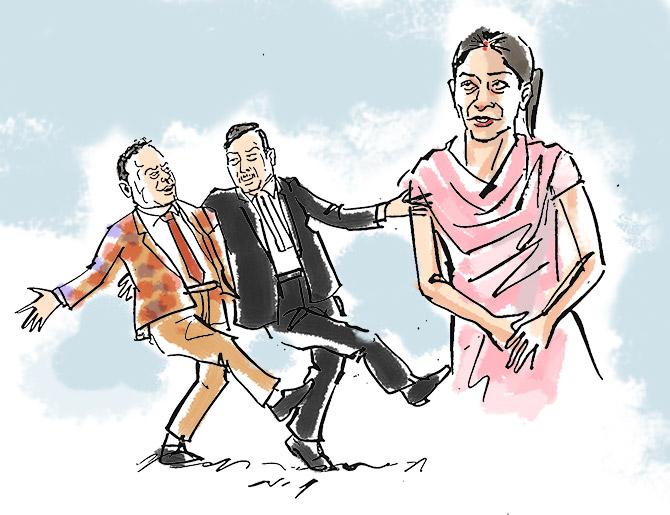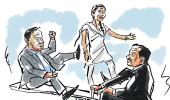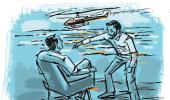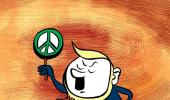Dressed in pink, her hands flying about in eloquent gestures, excitement on her face, Indrani made quite a picture.
There was pin-drop silence as she made strong points about why nothing in the hearings had uncovered anything against her.
She spoke about there being "Not a shred of evidence... No scientific evidence because it didn't happen!"
Vaihayasi Pande Daniel reports from the Sheena Bora murder trial.
Illustration: Dominic Xavier/Rediff.com

The cross-examination, in the Sheena Bora murder trial, on Thursday, January 21, and Tuesday, January 28, 2020, of Prosecution Witness 61 Dr Sudhir Kumar Gupta by Sudeep Ratnambardutt Pasbola at Courtroom 51 of the Mumbai city civil and sessions court, was perfectly civilised and courteous.
No acrimony. Or anger.
Both were in suits.
Pasbola, debonair, in his well-cut lawyerly black.
And Dr Gupta, a dapper dresser, in a striking brown suit with faint blue and red checks and a tie.
It was more like a meeting of equals in a congenial gentleman's club.
All ties and expensive suits.
All bonhomie and respect.
Pasbola struck the right chord with Dr Gupta and the cross-examination proceeded very smoothly and efficiently.
For every on-point question the lawyer asked, the doctor, placidly, calmly, always offered a very measured, cautious answer, never entirely disagreeing or agreeing, always carefully and diplomatically keeping the door ajar for both possibilities.
His favourite response was: "May or may not be."
There was no heat. Or argument. His answers were too considered to stir controversy or for the doctor and lawyer to be at loggerheads.
Rewind: Dr Gupta, 55, is the head of the forensic medicine department at the All India Institute of Medical Sciences, New Delhi. He has 25 years of experience. He hails from Ranchi, Jharkhand, and did his medicine from Jamshedpur and his forensic specialisation from Benaras Hindu University.
The Central Bureau of Investigation in 2015 invited the AIIMS to weigh in on the remains, believed to be Sheena's, exhumed from a quiet, forgotten spot in rural Raigad, Maharashtra.
Dr Gupta organised a team ('medical board'), headed by himself, to do an examination. They submitted a report. The bones had already been examined by the forensic department at the B Y L Nair Hospital, Mumbai, headed by Dr Shailesh Mohite.
1. Pasbola, like he had in earlier cross-examinations of forensic experts, once again brought up the issue of the need for a forensic anthropologist in this case, since they were best at dating a skeleton and the time since death and unearthing the cause of death.
The advocate wondered why none had been contacted.
Dr Gupta didn't feel they had much better expertise -- his answer was "maybe" -- although he conceded that they may be better at dating the age of the skeleton.
Pasbola: "You've written so many books. You've attended so many seminars. You have never met a forensic anthropologist at these conferences??"
Dr Gupta: "I may have met a forensic anthropologist in a seminar/meetings. Never felt that forensic anthropologist was in a better position to carry out the examination."
2. Pasbola had a series of queries about the site visit conducted by three members of the AIIMS team to Raigad.
Did the doctors prepare a report about it?
How long were they there? Had they taken photographs?
Did they do a bit of exhumation themselves?
To most of these questions, Dr Gupta answered that he did not remember.
But it emerged: "The three doctors did not scavenge the pit. I told them to look for smaller bones by taking assistance of CFSL (Central Forensic Science Laboratory) who were also part of the team."
When Pasbola heard that the CFSL doctors had been there, he quizzed Dr Gupta about the details of this team, their report etc -- to no avail.
3. Before the court Pasbola highlighted how the first postmortem had revealed that dried organs were found in the thoracic region and in abdominal region (of the skeleton).
The advocate asked: "You found they were not sent for histopathological examination... As a man of science these dried remains of tissues or organs should have been sent for chemical as well as histopathological examination (for the purpose of tracing poison etc)."
Dr Gupta said "Yes" but did not expand on why they had not been sent for testing.
4. Since there had been -- in one of the postmortems -- a reference to burning of the body, the lawyer made enquiries about the traces of petrol/kerosene on the bones and conclusions about what inflammatory substance was used.
Dr Gupta: "As a doctor I cannot find out which type of inflammatory material has been used for burning the skeleton."
Pasbola: "Did it occur to you to send the bones for chemical analysis to find out the cause of burning?"
Dr Gupta said yes, but he had not.
5. Pasbola asked Dr Gupta to see Page 12 of his report (submitted to the CBI).
The lawyer said with a grin: "This is the only part of the report I am extremely in concurrence with you -- the cause of the death."
The report stated since the body had been completely burned (as per the first postmortem), "The signs of strangulation are lost and could not be appreciated. The opinion of the board in absence of the laryngeal cartilages, muscles and hyoid bone (horseshoe-shaped bone in the neck) it could not be opined that the death was by strangulation."
Dr Gupta nodded.
Pasbola continued to read the report: "Manual strangulation or ligature could not be opined."
Dr Gupta with a smile, in a soft tone: "Appreciated."
Pasbola, also smiling, cajoled: "Opined," adding, in a conciliatory tone that that was a better word.
Dr Gupta sticking to his guns, again softly: "I am adding could not be appreciated."
6. There was a packet of bones that the AIIMS doctors returned to the CBI unopened and unexamined. Pasbola checked why that had been done.
These were the bones Dr Mohite had discarded saying they either belonged to another skeleton or were animal bones.
Dr Gupta said his team had not opened it because (as per the Nair hospital report) these bones were "not pertaining to Sheena."
It was further clarified that they had been returned to the CBI for onward transmission to the CFSI for investigation of the hair and skin, but Dr Gupta admitted he finally never received any such report.
Pasbola: "You realise this report from the CFSL was necessary?"
Dr Gupta confirmed: "Should have been done."
7. The cross-examination turned to the Karl Pearson method of estimating stature. The 20th century British mathematician/biostatistician derived a reconstruction formula for living stature from dry bones.
The Nair report on Sheena's remains had utilised this formula to calculate her stature.
He asked Dr Gupta: "Doctor, do you agree that Karl Pearson was used for establishing the stature of European and black population?"
There was some confusion about the terms European and black.
Pasbola emphatically: "White. Black population. We don't use the word negro," he explained because it was offensive.
Pasbola continuing: "...the more favoured one (now) is the Trotter and Gleser (derived in 1952 that factors in an error margin based on difference in races)?"
Dr Gupta nodded.
Elaborating on this point, Pasbola asked if any formula had been "derived (taking into account) the varied population of our country. On one side you have the Punjabis and on the other the Bengalis..."
Dr Gupta thoughtfully: "Studies have been done. No formula has been derived. Reference data has been given in almost all forensic textbooks."
Pasbola: "This reference data which you have said is 'hidden' in various books you have said is also intervariable?"
Considering the question for a moment, Dr Gupta agreed. He also agreed that data collected in India was still being analysed by the Karl Pearson formula.
8. Pre-lunch recess, Pasbola had his assistants quickly go back to his car/his office to retrieve various medical textbooks he had forgotten to bring to court.
After a gap, three textbooks appeared: Jaising P Modi's A Textbook of Medical Jurisprudence and Toxicology, K S Narayan Reddy and O P Murty's The Essentials of Forensic Medicine and Toxicology and Parikh's Textbook of Medical Jurisprudence Forensic Medicine and Toxicology for Classrooms and Courtrooms.
There was a laugh around the courtroom when the lawyer read the title of the last book. He added the book had many "quick solutions" in it.
Before and after the lunch recess several passages from these books were given to Dr Gupta to read. He was asked if he agreed with the points put across in the highlighted paragraphs.
Around then, the courtroom cat, nicknamed Sheena, strolled in, walking about the lawyers and around the witness. There was a bit of confusion.
Pasbola paused, citing with a laugh, "Feline interference."
The court peon, the tall Waghmare, in a white uniform, came in to gently chase the cat out, taking several minutes to do so.
CBI Special Judge Jayendra Chandrasen Jagdale told him in Marathi: "You are chasing it so slowly, how will it go?"
Finally, Sheena was sent on her way, not before causing a little disruption.
Based on what was in these textbooks Pasbola asked: "Now doctor, estimation of age is not a proof, but a medical opinion? Opinion about age has to be given on the findings of a physical, dental and radiological examination? Multiple criteria should be used to (determine) the age of a skeleton?"
Dr Gupta could not but agree with these points raised.
9. Pasbola brought up the topic of the skull superimposition tests and reports conducted by Dr Sunil Kumar Tripathi, Prosecution Witness 60 at AIIMS.
This was a sensitive point because much had been said in this courtroom about the pointlessness of the skull superimposition tests ordered by the CBI.
Dr Gupta seemed to be aware of it. Add to that: Dr Tripathi had been his professor when he was studying at BHU.
The doctor navigated, tippy-toes, the advocate's questions with aplomb.
Pasbola checked if AIIMS had been asked to conduct the superimposition.
If skull superimposition was an imperfect science?
Who had arranged how the test would be conducted? And so on.
Dr Gupta gave the impression he had facilitated the conduct of the test at the CBI's request, but seemed to have not wanted to involve himself and his institution with the test.
He acknowledged it was not an exact science and the test was not required.
Pasbola: "Did you go through the report?"
Dr Gupta: "Seen the report at the time."
Pasbola, with a laugh: "Happy it was in alignment with the CBI case?"
Dr Gupta, strictly judicious: "I was neutral."
Pasbola, a mischievous smile playing on his face: "You don't agree with that report?"
Dr Gupta, smiling broadly: "I have no comment." Laughter.
10. The final report from AIIMS, signed by Dr Gupta, had elaborated on four common causes of homicide as 'sharp force injuries, blunt force injuries, gunshot injuries and head injuries'.
In the case of Sheena's skeleton it had ruled out all four, by elimination, because of an absence of blood and injury to the bones. Therefore it pointed to strangulation.
Pasbola tackled this conclusion with Dr Gupta. He wanted to know how absence of blood was ruled out, when it was known, via Dr Mohite's testimony and 'cross', that he had washed the bones in water, rather than the preferred salt water, and could have, thusly, gotten rid of the blood.
Pasbola's Q-&-A went like this:
Pasbola, quizzically: "There are dozens of methods of homicide..."
Dr Gupta: "Yes, yes, yes."
Pasbola asked crucially: "Now, doctor, would it be correct to say that this opinion with regard to strangulation was a tentative opinion given based on the facts placed before you by the CBI?"
Dr Gupta was in agreement, adding: "Circumstantial evidence placed before me by the CBI, along with expertise and experience."
He added that exclusion was a way of determining the cause of death.
Pasbola, a few questions later, asked about the washing of bones.
Dr Gupta: "He had washed the bones with water to remove the entangled muds (mud) on the bones."
Pasbola: "In view of this washing less likelihood of seeing bleeding on the bones to the naked eye?"
Dr Gupta: "May or may not be appreciated."
Pasbola then called attention to the fact that if it was not visible chemical tests needed to conducted.
Pasbola: "But Dr Gupta, your report does not suggest any chemical tests. So I take it no chemical tests were done?"
Dr Gupta, without elaboration, straight-forwardly, "Yes."
Pasbola asked if over a period of time, especially in connection with a "body lying in a shallow grave" the blood composition "withers away."
Dr Gupta said it "disappears" and subsequently added: "May or may not."
Pasbiola again queried: "There is a word of caution introduced in your report when you say the same may be corroborated (by) carrying out further investigations. There is a word of caution to the investigators to conduct further tests to find out whether the report gets corroborated or not?"
Dr Gupta offered an unequivocal: "Yes."
Pasbola looked extremely satisfied.
11. Indrani Mukerjea's lawyer attempted to ask Dr Gupta about the complaint sent to the ethics committee of the Medical Council of India about the accusation of plagiarism against one of his papers.
CBI Special Public Prosecutor Manoj Chaladan, normally a very quiet presence in the courtroom, shot out of his chair and firmly declared: "Scandalous questions cannot be asked!"
Judge Jagdale immediately shut down this line of questioning by Pasbola too, angrily, his face thunderous, "It has already come on record. This is not the proper way."
Referring to a previous case that had come before the Supreme Court, he mentioned how a lawyer had been disbarred for asking questions that were potentially aimed at character assassination.
Judge Jagdale continued: "A person in authority always has to face allegations... Advocates have to also face these kinds of allegations."
But since the Supreme Court had ruled that these kinds of questions were not allowed, he asked if Pasbola still felt it wise to put such a question on record.
Finally Pasbola, given the presence of the media, agreed to give a written question to Dr Gupta.
Dr Gupta then wanted it on record. He replied: "This issue has been finally dismissed by the Medical Council of India. No penalty was issued."
Pasbola, in closing, offered his "suggestions" (courtroom term for accusations): "Doctor, it is my case to you that your opinion is erroneous and given only to favour the CBI. I put it to you that you hurriedly gave an opinion without examining the articles and conducting tests."
After Dr Gupta got off the witness stand and was frantically collecting his belongings, because he had a 6 pm flight to catch back to Delhi, Pasbola concluded with a smile: "Let us say he has been quite fair compared to the other doctors who have been here."
Smiles all around.
Before the cross examination started up on Tuesday, Indrani took the stand to argue her fifth bail application.
Dressed all in pink, her hands flying about in eloquent gestures, excitement on her face, Indrani made quite a picture.
There was pin-drop silence as she took off, making strong points about why so far nothing in the court hearings had uncovered anything actually against her.
She spoke very fast. The judge was slightly taken aback, but all ears, as she spiritedly belabored on.
She spoke about the presence of two skeletons, none of which could be conclusively proved to have a connection with her and the missing "cut on the skull". I came from behind (in court) to see the skull it. Everyone thought it was awkward. I came here to see the cut."
She spoke about how the alleged murder vehicle had been inaccurately identified as a Chevrolet when the last car her driver took had been an Opel Astra.
She spoke about the missing petrol that was used to burn the body. "Did I and Sanjeev Khanna throw the petrol beside of the body? Where did the 20 litres of petrol go?"
She spoke, nodding to Dr Gupta, about how no doctor in the world would give a false report about the cause of death.
"They are doctors. Their job is to save lives. That is their first oath. They are not going to give a report which is untrue which will send innocent people to the gallows."
She spoke about there being "Not a shred of evidence... No scientific evidence because it didn't happen!"
She spoke about the poor quality of the CBI and police investigation and what she said was their concocted narrative or "story" and how "the forensics in the case against me have collapsed."
Indrani was subsequently nudged out of the stand because Dr Gupta needed to complete his cross-examination first.
Wednesday, January 29, was set aside for Indrani to continue her dramatic arguments.
It was also suggested that these arguments are foolhardy and would undermine the defence's closing arguments.
But Indrani -- always impulsive, incorrigible, reckless, a never-say-die character, ever the optimist, ever the fighter -- wants her day in court.
Vaihayasi Pande Daniel covers the Sheena Bora Murder Trial for Rediff.com. You can read her brilliant coverage here.










